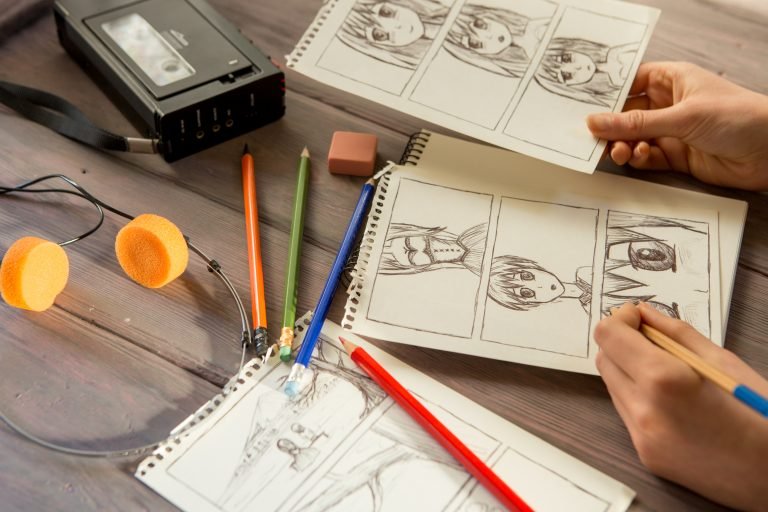When it comes to tools for traditional comic book drawing, having the right equipment can make a significant difference in the quality of your artwork. Whether you are a beginner or a seasoned artist, the tools you choose can help you express your creativity and bring your characters to life on the page. In this article, we’ll share some of the best tools for traditional comic book drawing that can enhance your artistic journey.
1. Pencils
Pencils are essential in the comic book drawing process. They allow you to sketch out your ideas and layouts without committing to ink right away. A variety of pencil grades are available, ranging from soft (B) to hard (H). For initial sketches, I recommend using a softer pencil, like a 2B or 4B, as it creates darker lines that are easier to see. Once your sketch is complete, you can switch to a harder pencil for cleaner, lighter lines.

2. Inking Pens
Inking pens are crucial for finalizing your drawings in traditional comic book art. They come in different types, including brush pens, felt-tip pens, and technical pens. Brush pens allow for a range of line thicknesses, making them great for dynamic inking. On the other hand, felt-tip pens provide consistent line quality and are easy to control. For precise work, technical pens are perfect, especially for detailed backgrounds and characters.
3. Markers
Markers are versatile tools for adding color to your comic book illustrations. Alcohol-based markers, such as Copic or Prismacolor, are popular among comic artists because they blend well and produce vibrant colors. They are ideal for adding depth and shading to your artwork. When using markers, it’s essential to work on marker-friendly paper to prevent bleeding and ensure smooth application.
4. Paper
Choosing the right paper is vital for successful tools for traditional comic book drawing. Look for smooth, heavyweight paper that can handle ink and markers without bleeding through. Many artists prefer Bristol board, which offers a sturdy surface for inking. If you enjoy working with watercolors or markers, consider using watercolor paper, which can absorb wet media without warping.
5. Erasers
Erasers are often overlooked but are an essential part of the drawing process. A good eraser can help you clean up your sketches without damaging the paper. Kneaded erasers are great for lifting graphite without leaving residue, while vinyl erasers are effective for more stubborn marks. Having both types on hand can be beneficial for different tasks during the comic book drawing process.
6. Rulers and T-Squares
When working on comic book layouts, precision is key. Rulers and T-squares help you create straight lines and perfect panels. These tools are particularly useful for ensuring consistent spacing and alignment throughout your pages. A clear ruler allows you to see your lines as you draw, which can be helpful for measuring and creating grids.
7. Lightboxes
Lightboxes are fantastic tools for tracing and refining your artwork. They illuminate your previous sketches, allowing you to ink over them without losing any detail. Using a lightbox can save you time and help maintain the integrity of your original drawing. This is especially useful when working on multiple drafts of the same comic panel or page.
8. Reference Materials
Having reference materials can significantly enhance your comic book drawing. This includes anatomy books, photo references, and even other comic books for inspiration. Observing how other artists handle poses, expressions, and backgrounds can help you improve your skills. Create a collection of resources that you can easily access when you need guidance or ideas for your artwork.
9. Portfolio and Storage
As you create your comic book pages, it’s essential to keep them safe and organized. Invest in a portfolio case or storage box to protect your finished artwork from damage. This also helps you keep track of your progress and allows you to showcase your work to others. A well-maintained portfolio can be a valuable tool for networking and sharing your artistic journey.
10. Online Tools and Software
While this article focuses on traditional tools, it’s worth mentioning that online tools and software can complement your work. Programs like Photoshop and Clip Studio Paint can help you edit and color your comic book pages digitally. Learning to use digital tools alongside traditional methods can expand your creative possibilities and streamline your workflow.
Essential Tools for Traditional Comic Book Drawing
Creating stunning traditional comic art requires the right set of tools, including quality pencils, inks, and brushes that bring characters and stories to life. Mastering these tools helps artists capture intricate details and dynamic expressions. When taking a break from drawing, many enjoy testing their skills with real money online blackjack for a fun challenge. Combining artistic focus with engaging entertainment makes for a balanced creative routine.
Conclusion
In conclusion, having the right tools for traditional comic book drawing can greatly enhance your artistic process and help you create stunning visuals. From pencils and inking pens to paper and storage solutions, each tool plays a crucial role in bringing your comic book ideas to life. By investing in quality materials and learning how to use them effectively, you can elevate your comic book art and storytelling.











